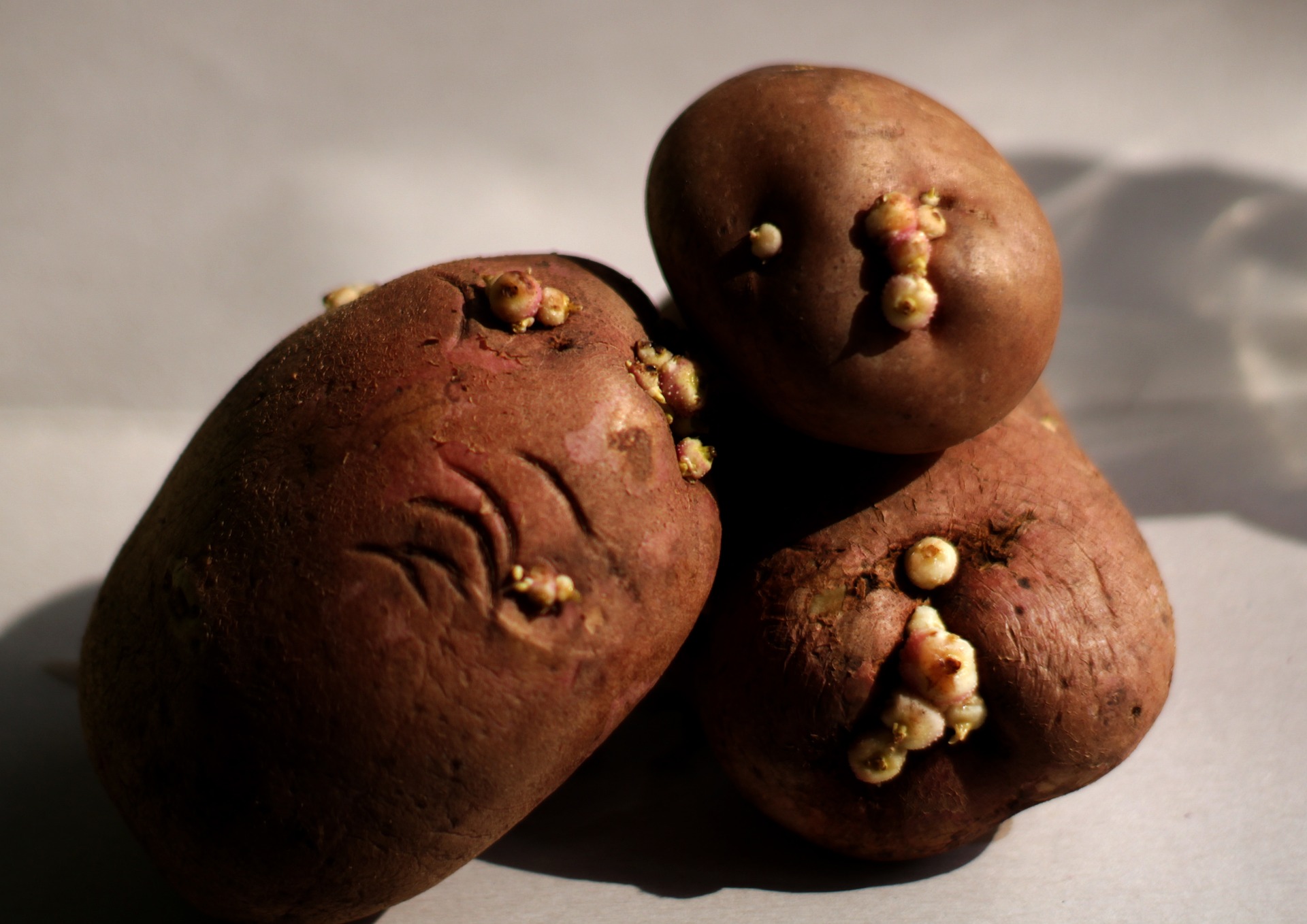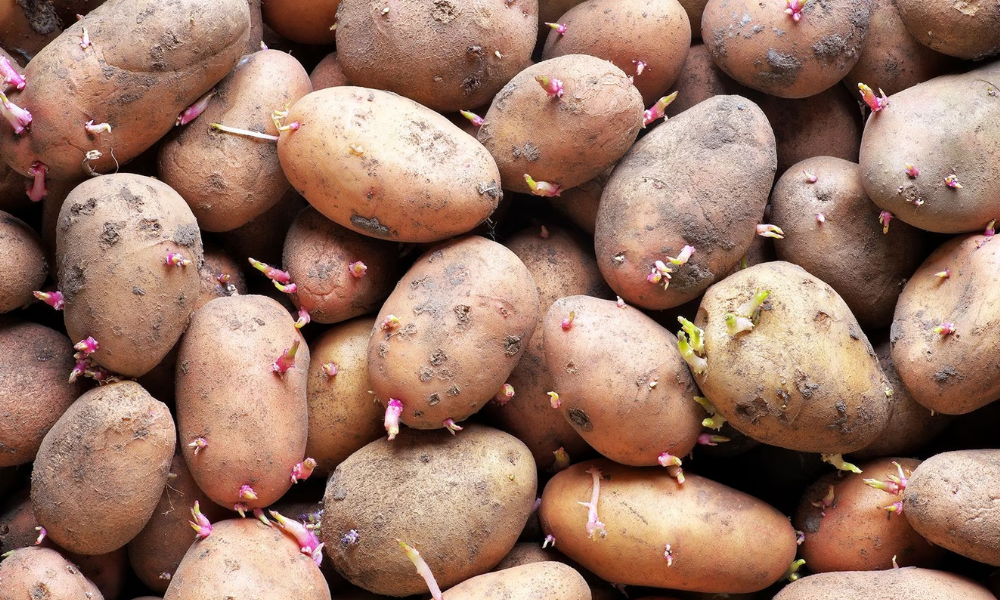A wholesome and useful produce option is potatoes. These tiny potatoes are a powerhouse of nutrients, high in fiber, vitamins, and minerals. Most potatoes are entirely safe to eat, but some contain a form of toxin that, if it accumulates, could make you feel unwell after eating. It is, therefore, advisable to keep an eye on how the potatoes you are storing are looking.
Potatoes may sprout and develop green patches as they age or result from incorrect storage. Finding out whether to eat those potatoes or not is the key concern. Check out the article below to know more.
Can you Eat Sprouted Potatoes?
The safety of eating potatoes has been questioned since they can start to sprout when kept in storage for an extended period.
On the one hand, many think that sprouted potatoes are okay to consume as long as the sprouts are taken out. On the other hand, others claim that sprouting potatoes are poisonous and can result in food poisoning, which could be fatal.
The nutrients in potatoes begin to deteriorate as they sprout because they are converted into sugar. They will fade up and become completely dangerous to consume if left unattended.
Before using sprouted potatoes in your diet, there are a few things to consider, but it can be a healthy way to eat. For instance, before cooking, think about how to store sprouted potatoes. Additionally, you must be aware of the dangers of sprouting potatoes.
How to Cook Sprouted Potatoes?
A normal stage of the potato life cycle is sprouting. It is the method by which potatoes convert starch into sugar. The young potato plant is then fed with these sugars.
But sprouting might be a concern. The poisonous chemical glycoalkaloids may be present in sprouted potatoes. The glycoalkaloids are poisonous and might possibly be fatal when consumed.
Potatoes with green areas should be discarded in order to prevent this. You can remove a green tint with a paring knife if you notice one.
Potatoes should be stored in a cold, dark area if you wish to keep them. They are less likely to sprout as a result of this. Additionally, it’s crucial to keep them away from onions. The sprouting process can be accelerated by onions.
Trim off any wrinkled portions of sprouting potatoes before cooking them. Potatoes with wrinkles are not very tasty. Before cooking, sprouts can also be eliminated by using a potato peeler.
Here’s a simple recipe for roasted sprouted potatoes:
Ingredients:
- 1lb sprouted potatoes
- One tablespoon of extra virgin olive oil
- 1/2 teaspoon black pepper and one teaspoon salt
- a half teaspoon of garlic powder
- paprika, 1/2 teaspoon
Instructions:
- Turn the oven’s temperature up to 400 degrees (200 degrees Celsius).
- Wash the potatoes and cut them into 1/4-inch slices.
- Combine the olive oil, salt, pepper, garlic powder, and paprika in a small mixing bowl.
- Place the potato slices on a baking sheet in a single layer.
- Brush the oil mixture over the tops of the potatoes.
- Cook the potatoes in a preheated oven for 20-25 minutes or until tender and beginning to brown.
- Serve the potatoes hot with your preferred dipping sauce or seasoning.
Alternatively, depending on your preference, you can boil, fry, or mash the sprouted potatoes. Just keep in mind that they may not hold their shape as well when cooked, making them unsuitable for some recipes.
How to Serve Cooked Sprouted Potatoes?
Roasted sprouted potatoes make an easy side dish for a variety of meals. Here are some ways to serve your roasted sprouted potatoes:
- As an accompaniment to grilled or roasted meats such as steak, chicken, or pork chops.
- As a salad or grain bowl, garnish.
- Served with eggs, bacon, and toast as part of a breakfast or brunch spread.
- Serve as a snack or appetizer with a dipping sauce like ranch dressing or aioli.
- As the foundation for a loaded baked potato with cheese, bacon, sour cream, and chives.
Remember to season the potatoes with salt and pepper before serving, and experiment with different herbs and spices to suit your preferences.
What Causes Potato Sprouts?
Potatoes don’t require dirt; occasionally, storage conditions encourage your potatoes to begin sprouting above ground! Your kitchen or pantry is a great spot to start cultivating “eyes” because all they require is darkness and moisture.
However, once you’ve removed the sprouts and cooked the potatoes, these extra appendages don’t mean you have to throw out your potatoes. The potatoes are still edible if they are firm when you squeeze them.
How to Remove sprouts with a Peeler?
Your vegetable peeler includes a secret feature that makes it simple to remove the sprouts: Whether it’s retro or Y-shaped, it was designed to get rid of brown patches and sprouts. To remove sprouts, use a standard peeler with a tip designed in the shape of a scoop. Or use the Y peeler’s side plastic tab to accomplish the same thing.
What is the Best Way to Stop Potatoes from Sprouting?
There are several methods for preventing potato sprouting:
- Potatoes should be kept in an area that is cold, dark, and well-ventilated. 45–50°F (7–10°C) is the optimal temperature range.
- Store potatoes away from onions because the gases they emit can cause potatoes to sprout faster.
- Remove any potatoes that have sprouted from your storage bin. These potatoes are still edible, but they may have a slightly bitter flavor and may not hold their shape as well when cooked.
- Treat the potatoes with a sprout inhibitor, such as a chlorpropham-containing product, which can be applied to the potatoes prior to storage.
- Before cooking the potatoes, remove the sprouts. This will not prevent new sprouts from forming, but it will remove any existing bitter-tasting sprouts.
By following these guidelines, you can keep your potatoes fresher, for longer and prevent sprouting.
How to Store Sprouted Potatoes?
In potato tubers, sprouts develop during storage. They may result in nutritional loss as well as wrinkling and shriveling of the tuber. Sprout suppressants can be used to manage sprouts.
The most popular sprout suppressant is CIPC. It was first used in the 1950s and has since been around for almost 50 years. It is a pre-emergence herbicide with a track record of success in suppressing sprouts.
CIPC is typically used as a post-harvest fogging treatment on stored potatoes and can be transformed into an emulsifiable concentrate or fogging combination. The storage conditions will determine how much CIPC is needed for sprout control.
Delaying sprouting is possible by keeping potatoes cold. Fresh-pack potatoes should be stored at 40 to 45 degrees Fahrenheit. They need to be kept in a breathable container, like a cardboard box or a breathable bag. The bag should have at least 90% moisture content.
Can Sprouted Potatoes be Poisonous?
When eating sprouting potatoes, solanine poisoning symptoms are rather uncommon. It should not, however, be taken lightly. Small amounts can mimic the signs of food illness.
Plants belonging to the nightshade family contain the substance solanine. Tomatoes, eggplant, berries, and potatoes are members of the family. When consumed in high quantities, glycoalkaloids from these plants negatively affect the body’s cardiovascular and endocrine systems.
As per the US National Institutes of Health, green-skinned potatoes are not advised to be consumed. The level of solanine production is indicated by the color of the skin.
As a neurotoxin, solanine has the potential to harm the nervous system seriously. Abdominal pain, vomiting, and nausea are among the symptoms. Often, a coma does not occur after solanine poisoning symptoms. If you suspect you may have consumed potatoes that have gone green, it is best to seek emergency medical attention.
Can the Solanine in Sprouting Potatoes poison Humans?
Compared to tubers, sprouts have substantially larger concentrations of glycoalkaloids. These glycoalkaloids can build up and harm humans with solanine. Diarrhea, a headache, a fever, and stomach pain are possible symptoms. There is no risk of injury if the solanine intake is less than 40 mg per 100 g of potatoes. If more solanine is ingested than this, it may result in coma and even death.
The alkaloid solanine is present in a variety of nightshade plants, including potatoes. In addition, it is present in tomatoes, eggplant, and other nightshade-family plants. Its capacity to damage cell membranes is chiefly responsible for its toxicity.
Several plants in the nightshade family include a class of poisonous compounds known as glycoalkaloids. These compounds have anti-cancer and anti-autoimmune properties, respectively. Animals may also experience digestive issues and birth deformities as a result of them.
The eyes and sprouts contain the highest glycoalkaloids. They take a while to decompose. They can, however, penetrate cells and harm healthy cells. Red blood cell membranes may become more vulnerable as a result. These compounds can induce vomiting and diarrhea at high doses. They can also lead to a wide range of neurological problems.
Reference: An Outbreak of Suspected Solanine Poisoning in Schoolboys
Conclusion
Although sprouted potatoes can be consumed, they may have a slightly bitter taste and may not hold their shape as well when cooked. They work best in recipes where the texture isn’t as important, like soups or mashed potatoes.
Sprouting potatoes are generally safe to eat as long as they are thoroughly cooked and show no signs of rot or mold. However, if the sprouts are too long or the potatoes are soft or shriveled, toss them. Always use your best judgment and discard any potatoes that do not appear or smell fresh.

